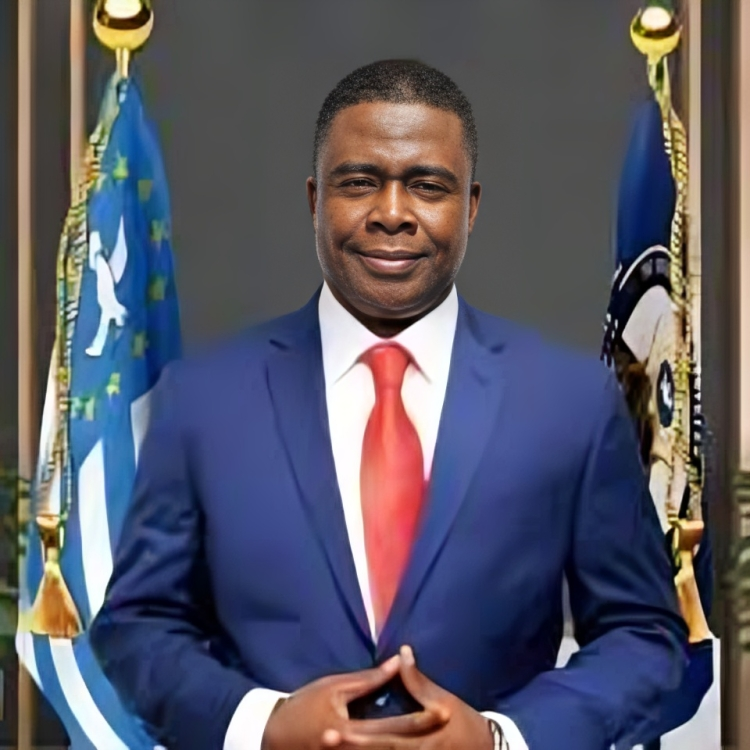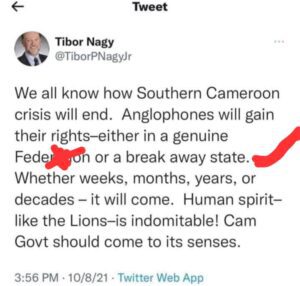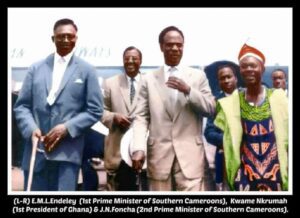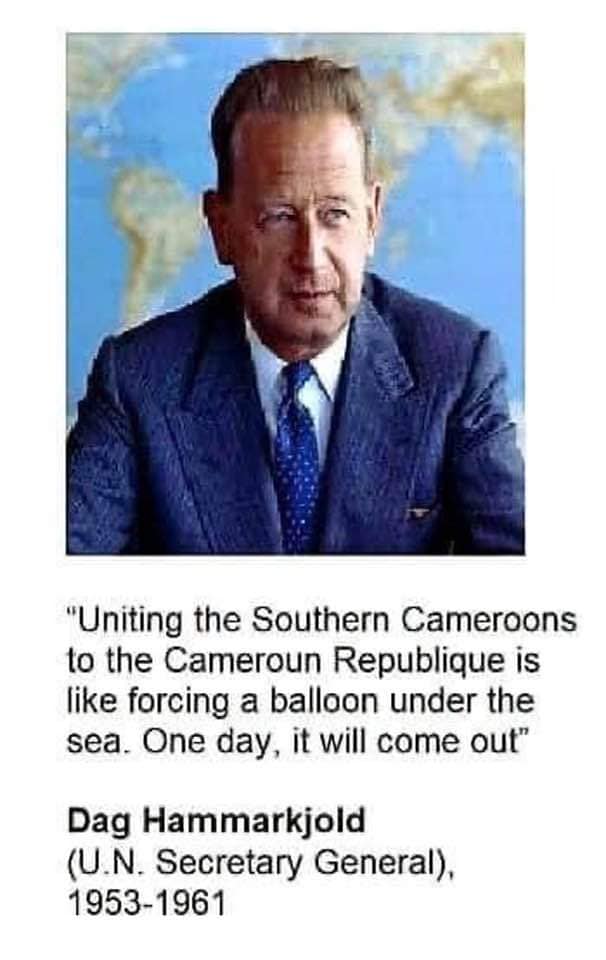THE SOUTHERN CAMEROONS (FEDERAL REPUBLIC OF AMBAZONIA) RESTORATION NEGOTIATIONS STRATEGY.
By Barrister Timothy MBESEHA
{Tel.+1(814)852 8001. Email Mbeseha@Yahoo.com}
The main purpose of this write-up is to remind ourselves that the Ambazonia restoration struggle is in its final phase. Sooner or later, the two parties, i.e., Ambazonia and La République du Cameroun, will, as a matter of necessity, have to meet face to face to address the root causes of the problem. This is why, as we prosecute the war, we must prepare ourselves for the inevitable face-to-face negotiations. We have consistently insisted that such negotiations must be conducted by an independent, mutually accepted mediator under the auspices of the United Nations. Needless to emphasize that the presence of international observers would lend credence to the process and its outcome.
We proceed under the assumption that those who would be selected to represent Ambazonia in the process already know the history and understand the intricate issues at stake. This opinion is therefore meant for those who are committed to the total restoration of British Southern Cameroons ( BSC)/Ambazonia statehood with its institutions. It is not meant for federalists and unionists.
It should, however, be recalled that over the years (1961-2017), the debates on the uncompleted decolonization of BSC/Ambazonia focused mainly on education and sensibilization of the citizenry. It was championed by individuals like the late Albert Mukong, Njoh Litumbe and Barrister Fon Gorji Dinka. Many groups/organizations, notably Cameroon Anglophone Movement (CAM), Southern Cameroon Peoples Organisation (SCAPO), All Anglophone Conference (AAC1) and the Southern Cameroons National Council (AAC2/SCNC) and the Consortium, have in the past five decades collectively or individually played very significant roles in educating the citizens. It is this continuous education that kept the spirit of resistance alive for more than five decades.
It should also be recalled that on the 30th of December 1999, late Justice Frederick A. Ebong, Pa Sabum and a few others stormed CRTV Buea and proclaimed the restoration of British Southern Cameroons’ independence. The bold move was quickly neutralized when Ebong was abducted and imprisoned in Yaoundé. Upon release, he left the country for the United States of America, where he was given asylum. He died in July 2019. Most of these individuals and groups focused essentially on the reform of the system and the return to federalism.
However, in 2016, protests for reforms by teachers of the NW&SW English-speaking regions and the Common Law Practising lawyers of the same regions were met with stiff resistance from the government. As a show of support for the teachers and Common Law lawyers, the civil society of the two English-speaking regions and the SCNC joined the protests. This is how the consortium of teachers, lawyers and civil society was born.
In addition to the original demands by teachers and lawyers, the newly created Consortium demanded that the unitary form of the state be revisited. In response, the government insisted that the form of state was non-negotiable. To show government firm resolve, the Consortium and SCNC, which were advocating for constitutional reforms to address the Anglophone problem, were banned. Some of the leaders of the two movements were apprehended and jailed, while others fled the country and sought refuge in neighbouring Nigeria. The leaders of the Consortium and the SCNC, who were able to escape arrest and found themselves in Nigeria, were joined by other Ambazonia liberation groups and activists. A combination of movements soon gave birth to a new organization called the Southern Cameroons United Front (SCACUF), headed by veteran comrade Deacon Tassang Wilfred. Deacon Tassang had been one of the leaders of the Consortium before its being banned. Now in Nigeria, SCACUF soon transformed itself into the Southern Cameroons/Ambazonia Governing Council, headed by Comrade Sisiku Ayuk Tabe. In a quick succession of events, SCACUF was replaced with the Ambazonia Governing Council, while the Governing Council soon gave birth to the Interim Government. Leadership also quickly changed hands when Comrade Deacon Tassang Wilfred was replaced by Comrade Sisiku Ayuk Tabe as leader of the Governing Council as the first President of the Ambazonia Interim Government.
The coming of Sisiku Ayuk Tabe to the helm of the struggle was marked by two important events, namely:
-1. The declaration of the restoration of Southern Cameroons’ independence on October 1st, 2017.
– 2. His emergence as the first President of the Interim Government of the Federal Republic of Ambazonia/BSC as per the final Resolutions of the 4th Conclave held in Zaria-Nigeria (Oct. 27th-31st, 2017). Because of the constitutional and strategic significance of these events, the continuous prosecution of the struggle should remain focused essentially on the restoration of BSC/Ambazonia independence and institutions.
The two events mentioned above lead to the conclusion that BSC/Ambazonia has moved past the constitutional reform agenda to full independence. Those who will represent us in future negotiations must bear this in mind. The legal and factual case for the restoration of BSC/Ambazonia statehood is easy to make, given that all the natural landmarks, such as streams and valleys, are still intact, while some of the Simon-Milner boundary pillars planted to demarcate the two territories remain traceable.
Documentary evidence to support the argument that LRC and BSC are separate entities in international law is massive. For example, (a) the fact that LRC attained independence on January 1st, 1960, without BSC/Ambazonia is indisputable, (b) the fact that LRC signed up to the AU Constitutive Act art. 4b limiting her territorial boundaries to what she was at independence on 1st January 1960 is not in doubt. The existence of many other United Nations documents that support our case lends more credence to the case.
The Restoration of BSC/Ambazonia institutions needs to be handled with more tact. BSC/Ambazonia was a territory with international demarcations and functional state institutions. The restoration, as declared by President Sisiku Ayuk Tabe on October 1st, 2017, must include the restoration of all Ambazonia state institutions. With regards to the institutions, we must acknowledge that some modifications have been made since the creation of the interim government. As we prosecute the struggle, necessary modifications will be made.
However, modifications must not be contradictory to the letter and spirit of the restoration vision enshrined in the October 1st, 2017, restoration proclamation. For example:
-A) The appellation Interim Government (IG) has been replaced with the Government of Ambazonia in Exile. This is because the government of the former BSC was not an interim government. Like in many other independence struggles around the world, restoration governments are based in exile pending when they will be safely installed on the ground.
– B) The Restoration Council has been changed to the House of Representatives because the BSC had a House of Representatives.
– Also, the House of Chiefs has been reinstituted to reflect the bicameral legislature that existed in the BSC)
– The interim constitution that was adopted to guide the struggle has been updated and renamed BSC/Ambazonia Orders in Council because the BSC constitution was called Orders-in-Council.
– D) There is a Justice Department, a reflection of the Southern Cameroons 1955 High Court Law. The above few examples are to illustrate why it is important for all independentists to prosecute the struggle under the name “Federal Government of Ambazonia” The idea of the BSC/Ambazonia restored state and institutions is what frightens La Republique du Cameroun. It is the most powerful winning strategy that we have against a powerful adversary that enjoys more diplomatic advantages. I think that one of the main reasons why LRC put in much capital to go beyond her national frontiers and abduct President Sisiku Ayuk Tabi and team was to decapitate the interim government of the time. They wanted to destroy anything that portrays any semblance of the restored state of BSC and her institutions. This might be one of the reasons why LRC rarely calls the BSC/Ambazonia government by name. LRC will rather talk of terrorist groups and claim that there is no one to talk to. This is why they pretend to negotiate with individuals and groups. We should learn not to fall into this manipulative strategy of divide and rule.
At this stage of the struggle, we cannot deny the fact that other factions and non-affiliated committed individuals are directly or indirectly involved in the prosecution of the struggle. That should not be our worry because in similar struggles worldwide, factions usually exist. From the experiences of others, we should model our own strategies.
Those groups and individuals who are using different appellations must be ready at the opportune moment to come together under the name of the Federal Government of Ambazonia. That is a winning strategy that we cannot afford to abandon at this stage. Such strategic planning should be done well in advance, not in the corridors of the negotiation room. What happened in the corridors of the failed pre-talks in Canada in the name of unity should, as far as possible, be avoided. The undisputable failure of the Canada adventure is evidenced in the fact that those who went there did not even issue a joint communique explaining what happened. The only information that has been publicly shared on the Canada charade is the AGOVC version as told by Capo Daniel, who represented AGOVC, not the Federal Government of Ambazonia.
A glance at what happened in Canada during the pre-talks is a reminder that negotiations in complex issues like the restoration of the statehood and institutions of a state is not a project for amateurs; it is a process that requires expertise and political savvy. I doubt if all those who fronted themselves in Canada had the necessary know-how in complex negotiations like Amazonia’s.
The selection of those to represent Ambazonia in negotiations was the main reason for the creation of the Ambazonia Coalition Team (ACT). The brain behind the creation of the Ambazonia Coalition Team (ACT) was President Dr. Samuel Ikome Sako, who had a good understanding of the issues at stake. He understood that many groups and important individuals are involved in the struggle, that negotiations would involve complex issues of give and take, that academic prowess and heavy political weight-lifting decision-making would be needed. The ACT was conceived not as a representative organization for a specific liberation group; it was meant to represent the people and state of Ambazonia. It was not the personal property of any group or individual, not even the President of Ambazonia. The Ambazonia Coalition Team was meant to pull all the resources needed, having to do with the anticipated negotiations. It was meant to overcome the visible lapses of the failed Canada pretalks, where some attendees posed as experts, few of whom had the minimum requirement to handle strategically complex issues that they were trying to handle.
In the best interest of Ambazonia, I think, we must get back to the principles that guided the creation of ACT because together we are stronger and probably unbeatable, our differences notwithstanding.
















